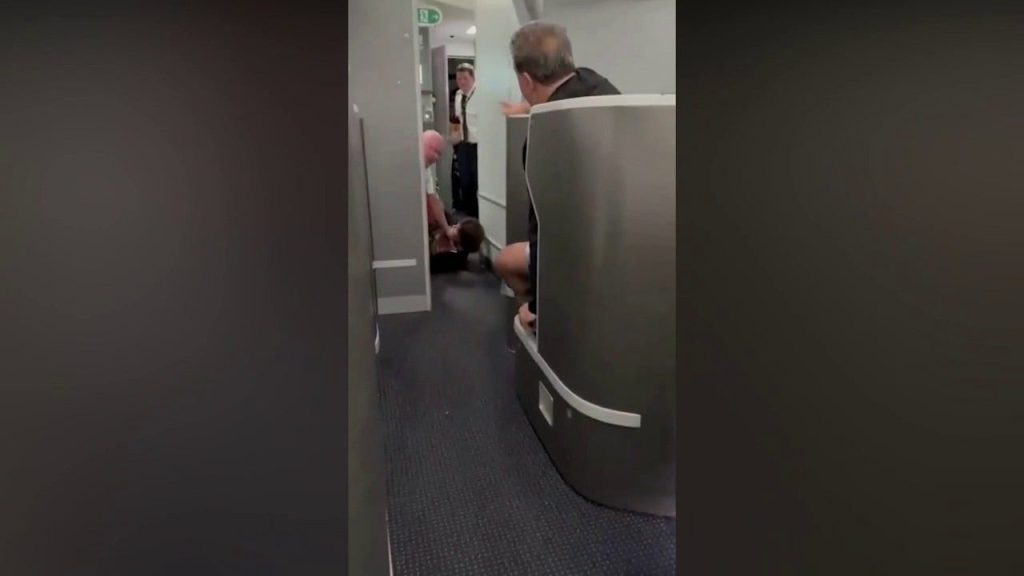A recent incident on American Airlines Flight 950 from São Paulo, Brazil, to New York City has drawn significant attention after video footage surfaced showing a passenger attempting to breach the cockpit. The altercation took place on April 24, 2025, aboard the aircraft before it had taken off. American Airlines stated that the flight returned to the gate due to a security concern, resulting in the removal of the involved passengers. This incident raises questions about airline security protocols and passenger behavior during flights.
| Article Subheadings |
|---|
| 1) Incident Overview: A Flight Disrupted |
| 2) Passenger Behavior: A Breakdown of Events |
| 3) Airline Response: Ensuring Safety |
| 4) Implications for Future Flights |
| 5) Previous Incidents: A Pattern of Disruptive Behavior |
Incident Overview: A Flight Disrupted
American Airlines Flight 950 was scheduled to travel from São Paulo, Brazil, to New York City on April 24, 2025. Just before the planned departure, the aircraft was preparing for take-off when an incident occurred that would create significant concern among passengers and crew members alike. Video evidence reveals that a female passenger attempted to forcefully enter the cockpit, which triggered a swift response from the airline’s staff. This behavior not only endangered the safety of everyone on board but also prompted the flight crew to take immediate action to restore order and security.
Passenger Behavior: A Breakdown of Events
As captured in the footage, a woman stood outside the cockpit door, attempting to gain unauthorized access. Reports indicate that another passenger intervened, shouting in Portuguese, perhaps in an attempt to dissuade her from her actions. The airline’s staff quickly moved to restrain the individual, leading to a confrontation where the woman was reportedly knocked to the floor during the struggle. This chaotic scene unfolded in the first-class cabin, highlighting the immediate threat posed by unruly passengers. Eyewitness accounts suggest that a sense of panic engulfed the cabin as passengers were understandably startled by the unfolding situation.
Airline Response: Ensuring Safety
Following the incident, American Airlines took swift measures to address the security breach and ensure the safety of its passengers and crew. In a statement issued to the public, an airline representative emphasized, “The safety and security of our customers and team members is our top priority, and we thank our customers for their understanding.” The flight was redirected back to the gate prior to departure, where law enforcement responded to the situation. American Airlines confirmed that the disruptive passengers were removed from the aircraft, and the flight was cleared to resume its journey shortly after, departing at approximately 12:55 a.m.
Implications for Future Flights
The incident on Flight 950 raises several important questions regarding air travel safety and passenger behavior. As airlines continue to navigate a post-pandemic world, ensuring the safety and security of flights remains a top concern. Experts in aviation have called for a review of pre-flight protocols and security measures, emphasizing the need for heightened vigilance to prevent similar situations in the future. The actions of one individual can impact the entire flight experience for all passengers, prompting discussions about the need for stricter enforcement of airline policies and further training for flight crew on handling unruly passengers.
Previous Incidents: A Pattern of Disruptive Behavior
This incident is not an isolated case. In recent months, the airline industry has seen an uptick in unruly passenger behavior, prompting the need for ongoing discussions about safety measures in commercial aviation. Of particular concern were previous incidents involving aggressive passenger actions, including one in which a traveler on an American Airlines flight injured a crew member. Such events highlight a concerning trend where cabin crew and passengers face increased threats to their safety. Airlines are now more than ever tasked with implementing effective strategies to deal with disruptive behavior, not just for the safety of their flights but also to maintain public confidence in air travel.
| No. | Key Points |
|---|---|
| 1 | Passenger attempted to forcibly enter the cockpit of American Airlines Flight 950. |
| 2 | Altercation resulted in the individual being restrained by airline staff and other passengers. |
| 3 | American Airlines returned the flight to the gate before departure due to security concerns. |
| 4 | Law enforcement was summoned to address the incident. |
| 5 | Previous incidents of unruly passenger behavior raise alarms within the aviation industry. |
Summary
The altercation aboard American Airlines Flight 950 underscores the ongoing challenges faced by airlines in ensuring passenger safety. As incidents of disruptive behavior persist, there is an urgent need for a reassessment of security measures within the aviation sector. Both airlines and regulators must work together to enhance protocols that protect all individuals onboard, making air travel safer for everyone. The response to this situation reflects the broader efforts that must be continuously undertaken to address growing concerns regarding passenger conduct in confined settings.
Frequently Asked Questions
Question: What happened on Flight 950?
On April 24, 2025, a female passenger attempted to storm the cockpit of American Airlines Flight 950, which was set to fly from São Paulo to New York City. The incident was captured on video, showing staff restraining the passenger before the flight returned to the gate.
Question: Why was the flight returned to the gate?
The flight was returned to the gate as a precaution due to concerns over passenger safety following the cockpit breach attempt. American Airlines prioritized the safety of all passengers and crew members as their top concern.
Question: What measures are airlines taking to ensure safety?
Airlines are increasingly focusing on enhancing security protocols, including staff training on handling unruly passengers and stricter enforcement of passenger behavior policies to prevent incidents that could endanger flights.


